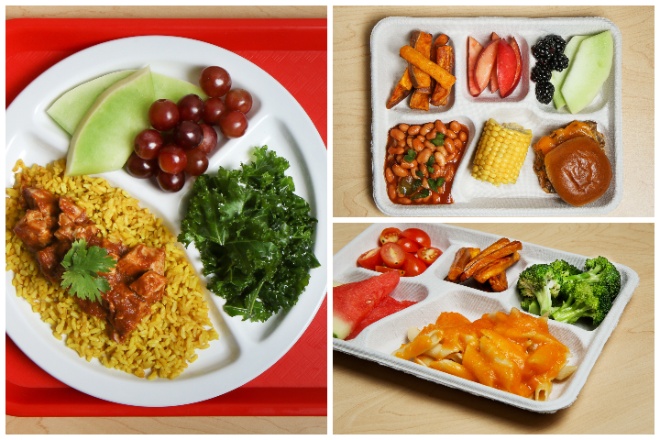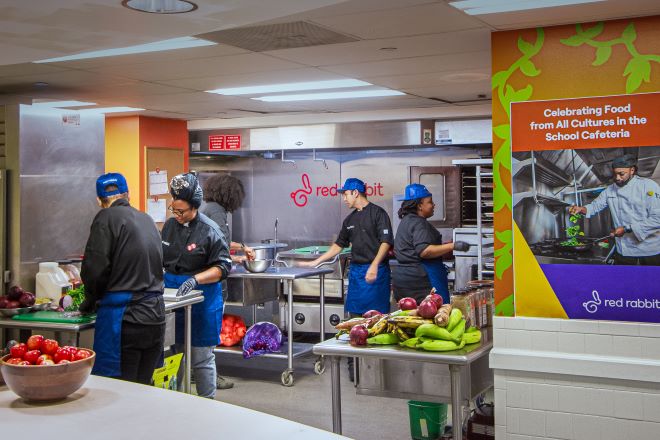Cafeteria food will likely never contend for the James Beard Awards. School meals are notoriously basic and bland, containing all of the food groups and none of the taste. Here in Philadelphia, where, at last count, 28.5 percent of children live in poverty, all District students receive free school breakfasts and lunches. It’s the law, and, in case you’re interested, it’s called the “community eligibility provision.”
But a lot of Philly kids avoid school meals. This academic year, Temple began using an NIH grant to figure out why. Could it be the macaroni’s soggy, peas are mushed, and the chicken tastes like wood?*
Meanwhile, two years ago, two Philly schools — K-8 charters Southwest Leadership Academy in Elmwood Park and Tacony Academy in Rhawnhurst — hired a company to, quite simply, make better things to eat. It seems to be working. The company making the food is Red Rabbit, a Harlem-based, Black-owned, for-profit outfit with the tagline, “Celebrating food from all cultures in the school cafeteria.” Red Rabbit is intent on proving that there is such a thing as a free lunch, and it’s delicious and good for you, in more than one sense.
Red Rabbit comes to Philly
On a recent Wednesday at Tacony Academy, kids dressed in yellow button-downs, khaki pants, and tartan ties and skirts file through their sprawling one-story building to the lunch room. Around 11:45am, a group forms a line at a hot bar, where Ron Wesson, a chef classically trained in French cuisine, dishes out beef stew, corn and carrots, herb-roasted potatoes and a mini baguette. As the students fill their trays, they pass a glass shelf containing colorful African baskets and posters of spice markets and select individually packed garden salads, fresh pineapple slices, hot sauces and, of course, blue cartons of low fat milk.

Beef stew may not be the student body’s number one favorite meal — Wesson says they like enchiladas, chili, and curry chicken and rice best — but no one’s turning it down. When it comes to creating an appetizing-to-kids menu, Wesson says, “We meet them halfway.” He and the staff of about five have a whole bunch of guidelines to follow, not just USDA rules around the food groups, but also their own: No pork (too many of the kids’ cultures prohibit it), no burgers or patty-based fare, absolutely no dino nuggets.
Yesterday’s lunch was barbecue chicken and mac and cheese. Tomorrow’s is chicken jambalaya, red beans and rice. The breakfast menu switches from blueberry muffins to banana bread pudding to French toast sticks to fruit yogurt and granola, depending on the day. Just about everything is made on the premises, including the granola.
Tacony Academy Director of Operations Todd Parker found Red Rabbit through a friend in New York. He, like Southwest Leadership Academy (SLACS) CEO Leigh Purnell, reached out to the company because, says Purnell, “A lot of our students are getting most of their meals at school. It was important that we’d be able to provide more holistic food options, more fresh food options for the students.” Generic versions of Cinnamon Toast Crunch and reheated chicken sandwiches were not cutting it. Plus, Red Rabbit’s fees are comparable to bigger, less personal, microwave-and-serve outside suppliers.
How Red Rabbit happened
Bahamian-born Rhys Powell left his job as a trader on Wall Street (and his engineering degree from MIT) to start Red Rabbit. Born into a family of entrepreneurs and foodies — he had a high school side hustle making and selling tamarind sauce — he started his company after a friend with a four-year-old asked him whether he knew if such a company existed. Powell looked into it, and found not much. (Google “wholesome school lunches,” and you’ll see results that include one Long Island food service company that has somewhat alarmingly trademarked the term “Real Meals.”)

He started Red Rabbit as more of a prepared food service for parents before quickly realizing he could and should go bigger. “As I learned more about school food and I learned more about the education system and the food system in general, the more I realized … it wasn’t necessarily about providing meals for busy parents, but something was fundamentally broken in our school food system,” he recently told the Metro. As a Black man who’d grown up well fed, he didn’t see just a business opportunity; he felt a moral responsibility.
Today, Powell refers to his company not as a food service provider, but as “a social justice organization that uplifts predominantly Black and Latino children inside public schools.” Like countless converts before him — José Andrés, Alice Waters — Powell sees healthful food as a fundamental right — and therefore views the fact of literally underserved populations living in food deserts and eating industrial school food as a societal injustice.
His challenge, then, was threefold: One: Feed kids wholesome food on a serious budget. The federal government reimburses most U.S. schools $4.25 per lunch, $2.28 per breakfast and $1.17 for after-school snack. Two: Feed these kids not just food they like — after all, the USDA now allows schools to serve Kraft Lunchables — but also food that represents their cultures, that they can be proud of. Three: Make a profit.
This last one is happening, Powell says, but not hugely. The company declined to share numbers but Red Rabbit V.P. Nausher Khan did say, “This is not a good business to make money, because you’re operating in a federally regulated market, so you cannot price lunches more than $4.25. I’ll be honest with you, I cannot make lunch for myself at home for that cost.”
It’s not like the USDA raises its reimbursement rates every time the price of chicken breasts increases. But Red Rabbit is getting by, by operating in bulk, wielding the buying power that comes with serving 5.5 million meals to students in 10 cities every year, and working with large purveyors who, in turn, work with small farms, like The Common Market on Erie Avenue. (Red Rabbit engaged The Common Market for New York and New Jersey schools before they started operating in Philly schools.) They also serve more than schools. During the summer, the Tacony Academy kitchen makes food for the Food Bank of South Jersey, based in Camden.
Another way to make ends meet is something financial advisor Suze Orman has been espousing for years: Homemade is cheaper. “It costs more to buy a blueberry muffin than to make one,” says Powell.
He and his team also recognize that school fare can be more than scratch-made. It can reinforce the validity of children’s cultures, and even “promote cross-cultural exchange,” says Powell, when kids talk about the food while they’re eating it.
“We realized that you can’t really measure the impact purely through the nutritive qualities of the meal. There is an experiential aspect to food and to what the kids were encountering in the cafeteria lunchroom,” Powell says. “There’s a dignity to eating on a plate, and there’s a dignity to eating in an environment that’s welcoming and well-designed, that feels nice.”
The cultural part is so important, Khan says, that when they come to a new school, “the first thing we do is get a much better understanding of the actual cultural makeup. You could be Black from from West Africa; you could be Black from South Africa, or from Southeast Asia.”
The approach is unusual. “Most school food companies start with the compliance requirements and they start with the budgetary requirements — all of the administrative things that need to get done. Ours works the other way around,” says Powell.
Red Rabbit touts its chefs’ culinary ingenuity. On their own, they’ve come up with dishes like jerk salmon, jollof rice and chana masala. “We try to make foods from all over the world,” says chef Wesson, who, like most Red Rabbit chefs and staffers, is Black. A former private chef, he appreciates the variety — in addition to the regular hours, weekends off, reliable salary and simply encountering the 900 or so kids he serves daily. “Being here,” he says, “it’s like flexing muscles.”
To be clear, the company’s drive to serve nutritious, culturally relevant meals to kids isn’t just good progressive PR. It’s good nutrition. Studies have found that kids who are exposed to a diverse range of flavors early on are more likely to develop healthy eating habits. The USDA and the American Dietetics Association recommend that schools serve food from a range of cultural backgrounds to reflect (and respect) what kids are used to eating at home.
To that end, Wesson describes the highest praise he has received from Tacony Academy students: “It’s nice to see kids be like, ‘Oh, yeah, my grandmother makes that.’”

Why not in other District schools?
If you’re a Philadelphia public school parent whose sixth grader, for example, would rather go without lunch and ride the bus home with a splitting headache than consume his school’s microwaved rigatoni, Salisbury steak, or something called a “cheese lasagna roll-up,” Red Rabbit’s deal might sound too good to be true.
For many cases, it is. Khan readily admits the company has not worked and probably won’t ever work within large school districts because of bureaucracy and sheer scale. In New York City, they serve about 20,000 out of 1.1 million students — a drop in the bucket. On the other hand, if they can do it, maybe your kids’ school can too?
In recent years, the School District of Philadelphia has closed school kitchens by the dozens, opting to outsource food from as far away as Brooklyn rather than deal with the hassle and expense of on-premises cooking. But that doesn’t mean those kitchens can’t reopen — or that commissary services can’t be better. Although Red Rabbit works onsite at SLACS and Tacony, they also serve plenty of other client schools through commissary kitchens, delivering fresh meals to heat and serve — and, like Chipotle, never using a freezer.
The ideal would be to get to a place where SLACS is. Says Purnell of her school’s fare, “It is all freshly prepared and it is beautifully served,” she says. “The students enjoy the variety. They enjoy the flavor profiles, and they enjoy the opportunity to sit down with a nice plate of food in the middle of the day to fuel them for the rest of their studies.”
*Thanks, Sugarhill Gang
![]() MORE ON OUR PUBLIC SCHOOLS FROM THE CITIZEN
MORE ON OUR PUBLIC SCHOOLS FROM THE CITIZEN



